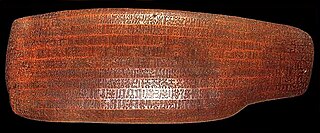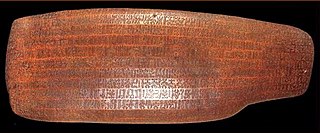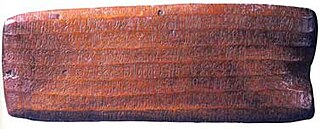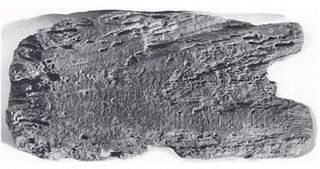
Text Y of the rongorongo corpus, known as the Paris Snuff Box, is one of two dozen surviving rongorongo texts.

Text Y of the rongorongo corpus, known as the Paris Snuff Box, is one of two dozen surviving rongorongo texts.
Y is the standard designation, continuing from Barthel (1958). Fischer (1997) refers to it as RR5.
The nickname in French is La Tabatière.
Musée de l'Homme, Paris. Catalog # 62-47-5.
A single unfluted tablet or part of a tablet, cut into pieces and assembled into a snuff box, 71 × 46–47 × 26–28 mm. It is variously said to be made from foreign driftwood or Pacific rosewood. The glyphs that remain, though crudely carved with a steel blade, are in excellent condition, except in the center of the bottom piece where they have been worn down. There are no glyphs on the inside, as the tablet was planed down to a thickness of 4–5 mm before being cut into pieces (Fischer 1997:497).
 | |||
 |  |  |  |
 | |||
Although the provenance for this object is not good, and being cut with a steel blade makes it suspect, both Métraux and Barthel believed it to be undoubtedly genuine. One reason is that it contains the rare glyph 36 and the rare compounds 38 and 684, and so is an unlikely forgery, though Barthel found out about it too late to include it in his catalogue. It was sold to the Musée de I'Homme in December 1961 by one Henry Reichlen, who had acquired it from a French family who had owned it for several generations — eighty years, by their count.
The box was presumably made by a sailor who did not recognize the value of the tablet. Since snuffboxes were more popular in the early part of the nineteenth century than later, when cigarettes became popular, it would likely have been acquired earlier than most surviving rongorongo texts.
The snuffbox has the repeated 380.1 glyph found on half a dozen other tablets which suggests it contains a list.
The top has three lines of glyphs, the bottom 2½, the four sides 1½. There are about 90 glyphs in all, many cut in half. Except for the front and back, which share a line cut lengthwise, the original relationship of the sections is not known.

Barthel (1958) did not transcribe this text, though he later accepted it as authentic.

Rongorongo is a system of glyphs discovered in the 19th century on Easter Island that has the appearance of writing or proto-writing. Numerous attempts at decipherment have been made, but none have been successful. Although some calendrical and what might prove to be genealogical information has been identified, none of the glyphs can actually be read. If rongorongo does prove to be writing and to be an independent invention, it would be one of very few inventions of writing in human history.

Rongorongo is a system of glyphs discovered in the 19th century on Easter Island that appears to be writing or proto-writing. Text A of the rongorongo corpus, also known as Tahua, is one of two dozen surviving texts.

Rongorongo is a system of glyphs discovered in the 19th century on Easter Island that appears to be writing or proto-writing. Text B of the rongorongo corpus, also known as Aruku Kurenga, is one of two dozen surviving rongorongo texts.
Text C of the rongorongo corpus, also known as Mamari, is one of two dozen surviving rongorongo texts. It contains the Rapa Nui calendar.

Rongorongo is a system of glyphs discovered in the 19th century on Easter Island that appears to be writing or proto-writing. Text D of the rongorongo corpus, also known as Échancrée ("notched"), is one of two dozen surviving texts. This is the tablet that started Jaussen's collection.

Rongorongo is a system of glyphs discovered in the 19th century on Easter Island that appears to be writing or proto-writing. Text E of the rongorongo corpus, also known as Keiti, is one of two dozen known rongorongo texts, though it survives only in photographs and rubbings.

Text G of the rongorongo corpus, the smaller of two tablets located in Santiago and therefore also known as the Small Santiago tablet, is one of two dozen surviving rongorongo texts. It may include a short genealogy.

Text H of the rongorongo corpus, the larger of two tablets located in Santiago and therefore also known as the Great or Large Santiago tablet, is one of two dozen surviving rongorongo texts, and one of three recording the so-called "Grand Tradition".
Text N of the rongorongo corpus, the smaller of two tablets in Vienna and therefore also known as the Small Vienna tablet, is one of two dozen surviving rongorongo texts. It repeats much of the verso of tablet E.
Text Q of the rongorongo corpus, the smaller of two tablets in St. Petersburg and therefore also known as the Small St Petersburg tablet, is one of two dozen surviving rongorongo texts, and one of three recording the so-called "Grand Tradition".
Text P of the rongorongo corpus, the larger of two tablets in St. Petersburg and therefore also known as the Great or Large St Petersburg tablet, is one of two dozen surviving rongorongo texts, and one of three recording the so-called "Grand Tradition".

Text R of the rongorongo corpus, the smaller of two tablets in Washington and therefore also known as the Small Washington tablet, is one of two dozen surviving rongorongo texts.

Rongorongo is a system of glyphs discovered in the 19th century on Easter Island that appears to be writing or proto-writing. Text F of the rongorongo corpus, also known as the (Stephen) Chauvet tablet, is one of two dozen surviving texts.
Text K of the rongorongo corpus, also known as the (Small) London tablet, is one of two dozen surviving rongorongo texts. It nearly duplicates the recto of tablet G.
Text V of the rongorongo corpus, the Honolulu oar, also known as Honolulu tablet 3 or Honolulu 3622, may be one of two dozen surviving rongorongo texts. Its authenticity has been questioned.

Text Z of the rongorongo corpus, also known as Poike, is a palimpsest inscription that may be one of two dozen surviving rongorongo texts. The authenticity of the upper text is in question.

Text L of the rongorongo corpus, also known as (London) reimiro 2, is the smaller of two inscribed reimiro in London and one of two dozen surviving rongorongo texts.

Text J of the rongorongo corpus, also known as (London) reimiro 1, is the larger of two inscribed reimiro in London and one of two dozen surviving rongorongo texts. It is also the shortest text in the corpus, being only two glyphs long.

Text M of the rongorongo corpus, the larger of two tablets in Vienna and therefore also known as the Large or Great Vienna tablet, is one of two dozen surviving rongorongo texts.
Text O of the rongorongo corpus, the Berlin tablet, is one of two dozen surviving rongorongo texts.